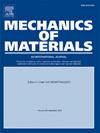Full-field elastic strain tensor evolution of 3D polycrystals with recurrent neural networks and transfer learning
IF 3.4
3区 材料科学
Q2 MATERIALS SCIENCE, MULTIDISCIPLINARY
引用次数: 0
Abstract
High energy X-ray diffraction microscopy (HEDM) is a non-destructive characterization technique that enables the study of material evolution under in situ thermo-mechanical conditions. While HEDM provides valuable insights, successful experiments require extensive planning, data collection, and data reduction, making them time-intensive and expensive. Crystal plasticity simulations could improve experimental planning and reduce the time required for experimental data reconstruction, but they are too computationally intensive for real-time experimental feedback. Deep learning models offer the speed needed for real-time feedback that could optimize data collection and data reconstruction while expanding the experimental design space. However, these models are currently limited by the small size of available training datasets. This work develops a surrogate crystal plasticity model using a U-Net architecture with recurrent and recursive connections to predict the evolution of full-field elastic strain tensors in 3D polycrystalline materials—properties directly measured during HEDM experiments. Using a Cu polycrystal as the baseline material, the trained network can make predictions instantaneously, representing a significant step towards real-time crystal plasticity predictions for HEDM experiments and potentially enabling more efficient and adaptive experimental designs. However, training such a 3D network for different materials system is computationally expensive due to its numerous trainable parameters and the cost of generating training data. To address this challenge, we investigate transfer learning techniques that enable the network to predict the evolution of different materials without training from scratch, while using the Cu-trained network as a foundation for expanding the model’s capabilities. The transfer learning approach successfully reduced training time and data requirements while maintaining prediction accuracy for materials with similar microstructures, demonstrating the potential for rapid adaptation to new material systems.
基于递归神经网络和迁移学习的三维多晶的全场弹性应变张量演化
高能x射线衍射显微镜(HEDM)是一种非破坏性表征技术,可以在原位热机械条件下研究材料的演化。虽然HEDM提供了有价值的见解,但成功的实验需要广泛的规划、数据收集和数据缩减,这使得实验耗时且昂贵。晶体塑性模拟可以改善实验计划,减少实验数据重建所需的时间,但对于实时实验反馈来说,计算量太大。深度学习模型提供了实时反馈所需的速度,可以优化数据收集和数据重建,同时扩大实验设计空间。然而,这些模型目前受到可用训练数据集规模小的限制。这项工作开发了一个替代晶体塑性模型,使用带有循环和递归连接的U-Net架构来预测三维多晶材料中全场弹性应变张量的演变-在HEDM实验中直接测量的性能。使用Cu多晶作为基准材料,训练后的网络可以即时进行预测,这是向HEDM实验的实时晶体塑性预测迈出的重要一步,并有可能实现更高效和自适应的实验设计。然而,由于可训练的参数众多以及生成训练数据的成本,训练这种不同材料系统的3D网络在计算上是昂贵的。为了应对这一挑战,我们研究了迁移学习技术,该技术使网络能够在没有从头开始训练的情况下预测不同材料的演变,同时使用cu训练的网络作为扩展模型功能的基础。迁移学习方法成功地减少了训练时间和数据需求,同时保持了具有相似微观结构的材料的预测准确性,展示了快速适应新材料系统的潜力。
本文章由计算机程序翻译,如有差异,请以英文原文为准。
求助全文
约1分钟内获得全文
求助全文
来源期刊

Mechanics of Materials
工程技术-材料科学:综合
CiteScore
7.60
自引率
5.10%
发文量
243
审稿时长
46 days
期刊介绍:
Mechanics of Materials is a forum for original scientific research on the flow, fracture, and general constitutive behavior of geophysical, geotechnical and technological materials, with balanced coverage of advanced technological and natural materials, with balanced coverage of theoretical, experimental, and field investigations. Of special concern are macroscopic predictions based on microscopic models, identification of microscopic structures from limited overall macroscopic data, experimental and field results that lead to fundamental understanding of the behavior of materials, and coordinated experimental and analytical investigations that culminate in theories with predictive quality.
 求助内容:
求助内容: 应助结果提醒方式:
应助结果提醒方式:


